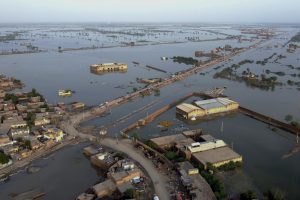35-year-old Noor and her family were at home when their roof collapsed. Their small, mud-brick house had been battered by violent storms for days on end. Noor was heavily pregnant, and expecting her fifth child any day. Unable to escape in time, she was crushed under the rubble.
Neighbors managed to pull Noor and her four children from the wreckage. Tragically, however, her husband did not make it. Pregnant, homeless, and grief-stricken, Noor had no choice but to sleep outside in the open with her children for two weeks. They’d lost everything.
Noor and her children were among 32 million people in Pakistan whose lives were devastated by last year’s unprecedented floods, which left 8 million people homeless. U.N. Secretary-General Antonio Guterres described the devastation as “climate carnage beyond imagination.”
The global climate crisis is already destroying people’s lives, but when it comes to climate disasters, all countries are not equal. Pakistan is only responsible for less than 1 percent of global emissions but suffered over $30 billion in loss and damage due to last year’s floods alone.
Across the world, it is the poorest and most disadvantaged communities that have lost the most as a result of the climate crisis – even though those same countries contributed the least to creating the catastrophe. Those who have little to begin with are pushed deeper into debt and destitution.
Children in poorer countries are the biggest losers of all. Climate disasters leave them hungrier, sicker, and more vulnerable to abuse and exploitation. Their schooling is interrupted or they stop learning altogether. All of this leaves them even more vulnerable when the next disaster hits.
This vast inequity was recognized by high-income, high-emitting countries at last November’s COP27 climate talks, in what was applauded as a “historic” agreement to set up a global “loss and damage” fund to provide financial assistance to vulnerable countries on the frontlines of the climate emergency.
Was this a sincere commitment to climate justice, or – in the words of renowned teenage climate activist Greta Thunberg – more blah, blah blah? Today we find out, as members of those same governments meet in Geneva for what will be a litmus test of their resolve to keep their promises to vulnerable countries.
The International Conference on Climate Resilient Pakistan, hosted today by the Pakistani government and the United Nations, is the first international donor conference to take place since COP27, and presents an opportunity for governments and donors to demonstrate their will and commitment to addressing the climate emergency by funding Pakistan’s recovery and reconstruction efforts.
In short, the world should be watching to see if high-income countries and historical emitters back their ambitious talk with real cash.
Pakistan’s government estimates it will need over $16 billion to build back flood-affected communities in a climate-resilient way. These funds are vital, not only to help those affected recover now, but also to limit the cost to Pakistan in terms of loss of life, destruction of homes and livelihoods, and damage to the national economy from future disasters and slow onset climate changes.
Noor gave birth to her daughter in a tent given to her by Save the Children. Aid agencies like us are doing everything we can to help families whose lives have been destroyed by the floods. We’re providing thousands of children and their families with food, medicine, and other essentials to help them get back on their feet.
But children like Noor’s newborn daughter – born into the world in an emergency tent – have the right to expect more from us. She has the right to grow up in a country that is greener, more climate resilient, and better able to protect itself when the next megaflood hits.
A promise to support the most climate-vulnerable countries is, after all, a promise to protect children’s futures. It’s a promise to build schools that withstand the impacts of climate disasters and improve children’s access to safe drinking water and healthcare. Collectively, governments must make sure children, wherever they are born, have a safe place to call home.
Is it a promise the international community will keep? Or, with the cameras gone, will rich countries turn their backs on the world’s most vulnerable children?
Let’s find out.
































